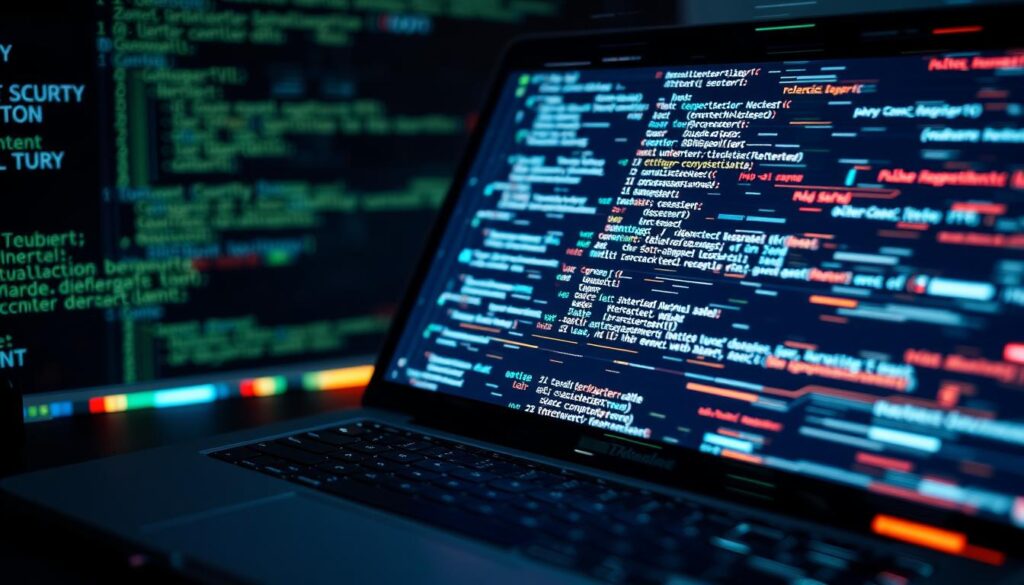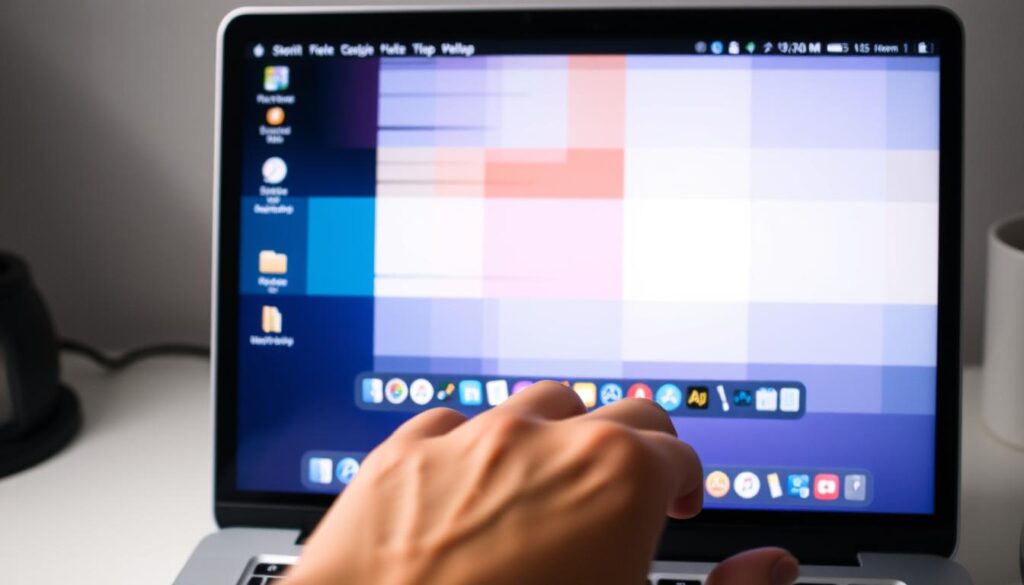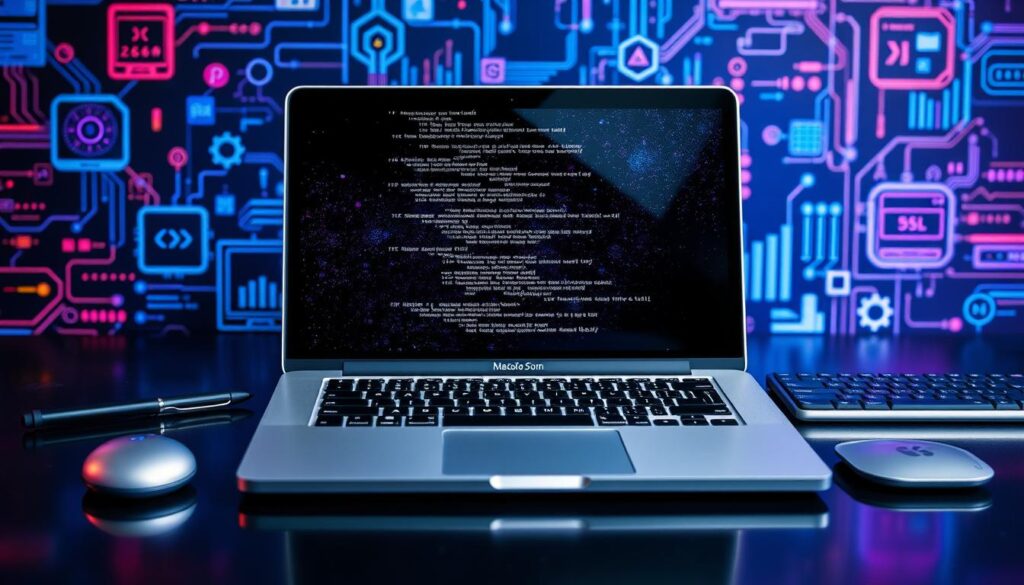Many people wonder why MacBooks don’t have touch screens. Apple sticks to keyboards and trackpads for a smooth work experience. They think touch screens are not needed for this.
Touch screens are common in Windows laptops, but Apple focuses on what works best. This makes users question if their MacBook touch screen problems are software or hardware issues. Knowing the difference is key to fixing these problems.

Key Takeaways
- Apple has historically avoided touchscreen software integration in MacBooks for ergonomic reasons.
- Many users face challenges that raise questions about whether the issues are software-related or hardware-based.
- The Touch Bar, introduced in 2016, showcased Apple’s experimental approach to touch features.
- MacBook touch screen issues often involve software updates and compatibility checks.
- Understanding the technological background behind the MacBook’s design can clarify touch functionality perceptions.
- Rumors suggest that Apple may finalize touch-enabled MacBooks as early as 2025.
Software Possibilities: Exploring Possible Software-Related Causes
Many software-related issues can cause problems with a macbook touch screen. Glitches often happen after software updates. These updates can make the screen flicker, making it hard to use the device.
macOS Updates and Glitches: How Software Updates Can Affect Functionality
Upgrading to new macOS versions can lead to performance issues. For example, some users on Sonoma version 14.3.1 faced Touch Bar problems. Bugs in these updates can cause touch screen glitches, making it hard to use the device.
Driver Issues: Compatibility and Troubleshooting Driver Problems
Driver compatibility is another big problem. Old or damaged drivers can make the touch screen less responsive. If you’re having trouble with your touch screen, checking and updating your drivers might help.
Accessibility Settings: Checking for Touch-Related Settings and Features
Accessibility settings can sometimes cause issues. Users might accidentally turn off touch features, leading to confusion. Make sure these settings are right to avoid touch problems.
Third-Party App Interference: Investigating if Apps Are Affecting Touch Input
Third-party apps can sometimes cause problems with macOS. They might make the screen flicker or glitch. Tools like EtreCheck can help find these apps and fix the issues.
| Solved Issue | Method | Effectiveness |
|---|---|---|
| Touch Bar Functionality | Update macOS | 20% of users reported resolution |
| Screen Flickering | Reset NVRAM | Effective in stabilizing graphics |
| Driver Problems | Reinstall Drivers | Significantly improves responsiveness |
| Accessibility Confusion | Default Setting Check | Restores functionality |
| Third-Party Interference | EtreCheck Diagnostic | Identifies problematic apps |
Hardware Limitations: Understanding the MacBook Design
MacBooks don’t have touchscreens because of important hardware reasons. Apple designs each part carefully to ensure top performance and user experience. Adding touch technology to the MacBook display could lead to problems like screen calibration issues or extra weight.
The MacBook Display: Engineering and Technology Behind the Non-Touchscreen
The engineering of the MacBook display is both creative and thoughtful. Unlike touch devices, MacBooks have high-resolution screens that focus on clear images and colors. Touch capabilities could make the device more fragile, leading to issues like a black screen. Apple aims to keep its devices premium by avoiding these problems.
Trackpad and Mouse Focus: macOS Prioritizes Traditional Input Methods
macOS is designed to work best with keyboards and trackpads. Users doing tasks like coding or graphic design find these methods more precise. Apple believes fingers are better for touch on iOS, not macOS. This shows Apple’s focus on user experience over following trends.
Design Philosophy: Apple’s Approach to User Interface and Interaction
Apple’s design philosophy is about making things easy and efficient for users. By keeping touch features for devices like the iPad, Apple meets different user needs. This shows Apple understands how people use technology, making sure each device has a specific role. These design choices are key in talks about touchscreens in laptops.

Troubleshooting Steps: What to Try if Your MacBook Seems Unresponsive to Touch
If your MacBook screen won’t respond, there are steps to help. Start with simple fixes for minor software problems.
Restart Your MacBook: A Simple Fix for Temporary Software Glitches
Restarting can fix temporary software issues. Save your work and go to the Apple menu. Then, select Restart.
If your MacBook is frozen, press and hold the Power button. Wait until it turns off, then turn it back on. This quick fix might solve the problem.
Check for macOS Updates: Ensuring Your Software is Up-to-Date
Outdated software can cause touch screen errors. Go to System Preferences and select Software Update. It’s important to keep your software updated.
Update or Reinstall Drivers: Addressing Possible Driver Conflicts
Driver issues can affect touch functionality. Look for updates for your MacBook model. If problems continue, try reinstalling drivers after removing old versions.
Run Hardware Diagnostics: Identifying Possible Hardware Issues
If the touch screen is unresponsive, run hardware diagnostics. Restart your MacBook and hold the D key during startup. This will access Apple Diagnostics and help find hardware problems that might need professional help.
Alternatives to Touchscreen on a MacBook
MacBook users without a built-in touch screen have many alternatives. These options can make using your MacBook easier and more productive. They can help solve problems like a macbook touch screen issue or when the touch bar doesn’t work right.
Trackpad Gestures: Mastering Multi-Touch Gestures for Navigation
Trackpad gestures are a great way to navigate. Learning these gestures lets you scroll, zoom, and switch apps easily. Knowing these gestures well can make your MacBook work smoothly, even without a touch screen.
External Touchscreen Displays: Connecting a Touchscreen Monitor for Specific Needs
For those who want to use touch, an external touchscreen display is a good choice. The Dell P2424HT monitor works well with an M2 Mac Mini. It’s a cost-effective option, as its drivers are free, unlike the usual $150 price tag.
Using a touchscreen display makes your MacBook more versatile. It helps overcome the design limitations of Apple’s products.
iPad Integration with Sidecar: Using an iPad as a Secondary Touchscreen Display
Apple’s Sidecar feature lets you turn an iPad into a second screen for your MacBook. This setup offers a mix of touch and traditional input. It makes your workflow more flexible, boosting productivity in creative and professional tasks.

| Alternative Method | Description | Benefits |
|---|---|---|
| Trackpad Gestures | Utilizes multi-touch gestures for navigation on the MacBook trackpad. | Enhances efficiency in performing various tasks without needing a touchscreen. |
| External Touchscreen | Connects monitors like the Dell P2424HT to offer touchscreen functionality. | Provides multitouch capabilities and an interactive display experience. |
| iPad Integration | Uses Sidecar to enable iPad as a second touchscreen. | Augments workflow with touch input, increasing productivity. |
The Future of Touchscreen MacBooks
There’s a lot of talk about Apple making a touchscreen MacBook soon. Reports say they might show one in 2025. This move would meet the growing demand for touchscreens on MacBooks, unlike what Asus, HP, and Dell offer.
Rumors and Speculation: Will Apple Ever Release a Touchscreen MacBook?
Many people are excited about the idea of a touchscreen MacBook. The removal of the Touch Bar from newer models has sparked debate. Users miss the Touch Bar for its productivity boost, wondering how a touchscreen would enhance their experience.
Potential Benefits and Challenges: Weighing the Pros and Cons of Touchscreen Integration
Adding a touchscreen to MacBooks could make them easier to use. But, it might also increase costs and affect how they feel in your hands. Apple needs to balance old and new features well. Users are eager to see how a touchscreen would work with macOS.
The Evolution of macOS: Adapting the Operating System for Touch Input
For a touchscreen MacBook, macOS would need big changes. Touch input means a new interface that’s easy to use. Apple is looking into new display tech, like microLEDs, for future MacBooks. The talk about touchscreens shows Apple is moving in a direction that meets user needs and tech advancements.
FAQ
What should I do if my MacBook screen is not responding?
First, try restarting your MacBook. This can fix temporary software problems. If it doesn’t work, check for macOS updates. These can solve bugs that affect the screen.
Also, look into driver issues and make sure your accessibility settings are right.
How can I fix a flickering screen on my MacBook?
Start by updating your macOS to the latest version. This can help fix display issues. Also, check for driver problems, as old or broken drivers can cause problems.
If the issue persists, run hardware diagnostics. This can show if there are hardware problems that need fixing.
Why is my MacBook’s touch bar unresponsive?
Try restarting your MacBook to fix minor software issues. Make sure your macOS is updated. This can improve how the touch bar works.
If it’s not working, try resetting the touch bar using Terminal. Also, check for apps that might be causing problems.
Are there alternatives to a touch screen on a MacBook?
Yes, there are ways to use your MacBook without a touch screen. Learn to use multi-touch gestures on the trackpad. This can help you navigate easily.
You can also use an external touchscreen display for tasks that need touch input. Using an iPad as a secondary display is another option.
Is the lack of a touchscreen in MacBooks due to hardware limitations?
Yes, Apple chose not to include touch screens in MacBooks for hardware reasons. They want to keep high display quality and performance. Adding touch technology could affect the display and weight, not fitting Apple’s design goals.
How can I troubleshoot my MacBook touch screen issues?
Start by restarting your MacBook. Make sure your macOS is updated. This can solve software problems.
Check or reinstall drivers for compatibility issues. If problems continue, run hardware diagnostics to find hardware defects that need fixing.
Check out this new gadget at software solutions for wayfinding
Will Apple ever release a touchscreen MacBook?
There are rumors about Apple making a touchscreen MacBook. But, their design focus is on traditional input methods. Adding touch technology would require big changes to macOS and might bring both benefits and challenges.